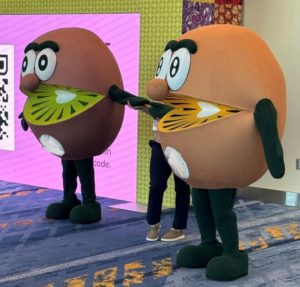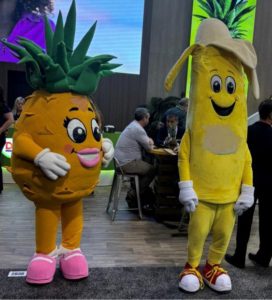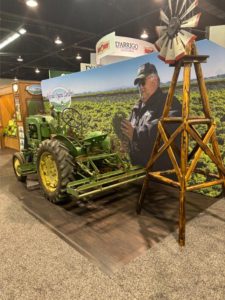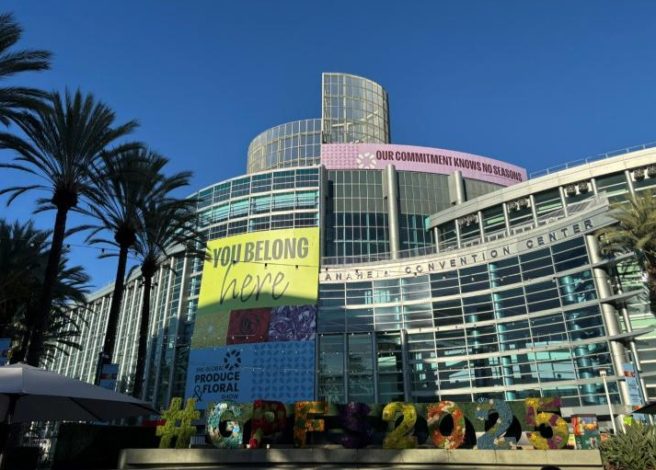At a Glance
- IFPA show takeaways: IFPA proved the produce industry isn’t waiting for change — it’s creating it.
- “Fight for Fresh”: The new rallying cry for collaboration and access to fresh food.
- Traceability + tech: Smart systems are redefining packaging and compliance.
- Gen Z’s view: They want better packaging, not less packaging.
Fresh off the show floor at IFPA’s Global Produce and Floral Show in Anaheim, I’m still buzzing from everything I saw, heard, and learned.
It’s Mark (again), Content Manager Extraordinaire at Inline Plastics. When the opportunity to attend the show came up, I knew it was time to roll up my sleeves and get ready for another round of industry education.
There was one thing I knew for sure: Since this was a produce show, I was pretty confident the free samples would be a little friendlier on my waistline than the ones at the last trade show I attended. Spoiler: That was the International Baking Industry Exposition (IBIE) — think: A sea of croissants.
As someone who spends their days thinking about how to keep food fresh and safe, attending a show where the entire industry gathers to tackle the biggest challenges in produce was like finding my people. And right now, those people are facing some serious challenges: New regulations dropping faster than anyone can keep up (hello, FSMA 204 in January 2026), sky-high sustainability expectations, and supply chains more complicated than ever.
The energy at The Global Produce and Floral Show, put on by IFPA, was different from other trade shows. Sure, there were booth displays and product demos, but there was a greater sense of urgency. Industry leaders didn’t just talk about innovation; they wrestled with the hard questions about traceability, sustainability, and the future of fresh food.
Here are my seven biggest takeaways from a show that proved the produce industry isn’t just thinking about tomorrow — it’s actively building it.
“Fight for Fresh” is the Industry’s New Battle Cry
IFPA’s CEO opened the show with a phrase that immediately became everyone’s unofficial motto: “Fight for Fresh.”
The fresh produce industry is getting squeezed from every direction. Tariffs are unpredictable. Regulations keep tightening. Consumers want sustainability but also affordability. And everyone’s expected to make it all work while keeping razor-thin margins.
The message was clear: The only way through this is together. It’s going to take advocacy, collaboration, policy work — the whole nine yards. For those of us in packaging, it was a reminder that we’re not just making containers. We’re supporting an entire ecosystem that’s literally fighting to keep fresh food accessible.
And speaking of clear messaging, I didn’t realize that IFPA would have so many mascots.

So many mascots.




Some mascots raised a few eyebrows.


And some missed the mark entirely.

Traceability is No Longer Optional
With FSMA 204’s compliance deadline hitting in January 2026, every session circled back to the same question: “Can you trace your product from farm to fork in 24 hours?” FSMA 204 is the FDA’s food traceability rule requiring detailed recordkeeping for high-risk foods — think leafy greens, tomatoes, melons, and fresh-cut fruits.
One grower claimed they followed every compliance protocol to the best of their ability, but still got blamed for a contamination issue because distribution centers in the chain dropped the ball. They couldn’t prove it wasn’t their fault because the traceability chain was broken.
The good news? The technology exists. The shift from FIFO (first in, first out) to FEFO (first expired, first out) is gaining traction, and companies are already tracking products in real-time.
For those of us in packaging, this means our containers need to work with scanners, sensors, and digital tracking systems. These smart labels adhere right onto containers, providing detailed information about the supply chain.
Gen Z Doesn’t Mind Packaging
 A researcher from Circana got on stage and dropped this gem: Gen Z is way more willing to pay for packaged produce than older generations.
A researcher from Circana got on stage and dropped this gem: Gen Z is way more willing to pay for packaged produce than older generations.
I’m sorry, what? This one genuinely surprised me.
Turns out, Gen Z doesn’t hate packaging — they hate wasteful packaging. There’s a difference. They see packaging as protection, quality assurance, and convenience. They want their food to stay fresh longer. Also, they want it to survive the trip from the store to their home without getting crushed. And they’re willing to pay for that, especially if that packaging is considered sustainable.
But here’s the catch: If it doesn’t add real value, they’re not that interested. But if it keeps their berries fresh for an extra three days? They’re fans.
Calling Something “Local” Can Mean Different Things
The session on global versus local produce trends revealed something fascinating: Nobody can agree on what “local” actually means.
In the U.S., some consumers think “local” means the same state. Others say within 100 miles. Some think it just means “grown in America.” In Asia, “local” often means the same country. And for some shoppers, it apparently just means “available at my local grocery store.”
So basically, “local” is like “natural” or “artisanal” — it sounds great but means absolutely nothing without context.
My takeaway? Don’t assume your definition of local matches anyone else’s. Test your messaging and be really specific, rather than relying on vague, feel-good words.
Half of Americans Buy Their Produce from the Same Place
According to a survey conducted last year by Circana and the International Fresh Produce Association (IFPA), nearly half of Americans named Walmart as their favorite place to buy fresh produce. The survey specifically asked participants to identify their primary source for purchasing fresh produce.
This has massive implications for anyone working in the fresh food industry. When a major retailer decides they care about traceability, the whole industry pivots. When they set sustainability standards, suppliers scramble to comply.
For packaging suppliers, this means paying very close attention to what major retailers are prioritizing — because whatever they’re talking about today will be a requirement tomorrow.
It’s not about loving or hating big-box retail. It’s about understanding the landscape and adapting accordingly.
 AI is Everywhere (Even in Fresh Produce)
AI is Everywhere (Even in Fresh Produce)
AI showed up in nearly every session at IFPA, but thankfully, it wasn’t the overhyped “AI will solve all of our problems” mumbling you hear at some conferences. These were actual, practical applications already being tested:
- Smart forecasting to match supply with demand and reduce waste
- Shelf-life calculators that predict freshness based on real-time supply chain data
- Digital twins that create visual representations of growing processes
- On-tree scanning using drones to analyze ripeness and forecast yields (especially useful in citrus)
For packaging, this means designing containers that integrate with these smarter systems.
Food Waste Can Actually Be Food Profit (If You’re Smart About It)
The upcycling panel was hands-down my favorite session. Speakers talked about turning unused produce into sauces and purees, framing it not as charity work but as smart business. One panelist nailed it: “Waste has to be monetized to make a product upcycled.”
Another speaker asked the question that reframed everything: “Is it food waste or food profit?”
This isn’t about being noble (though that’s nice too). It’s about finding revenue in places you previously saw as a loss.
The companies winning in sustainability aren’t just checking boxes — they’re turning environmental responsibility into a competitive advantage.
What Did IFPA Really Produce This Year?
 The fresh food industry is facing serious challenges: FSMA 204 compliance is looming, sustainability pressures are mounting, consumer expectations are shifting, and supply chains are more complex than ever.
The fresh food industry is facing serious challenges: FSMA 204 compliance is looming, sustainability pressures are mounting, consumer expectations are shifting, and supply chains are more complex than ever.
But here’s the other truth: The solutions are already being built. Smart people are collaborating across the industry to figure this out. Technology is improving. Systems are getting better.
For those of us in packaging, our job is to support that progress — not slow it down. We need containers that work with traceability systems, extend shelf life, reduce waste, and meet sustainability standards without bankrupting anyone.
Is it a lot? Yes. Is it overwhelming? Sometimes. But is it also kind of exciting to be part of an industry that’s actively trying to get better? Absolutely.
IFPA reminded me about the important work we do at Inline Plastics. Sure, it may just look like food packaging. But those containers help keep food fresh, reduce waste, and support an industry that literally feeds people. And maybe next year, there will be a Safe-T-Fresh mascot, which I will happily volunteer to be.
Are you interested in learning more about packaging for fresh food? Visit our Learning Center today and explore a variety of topics.

